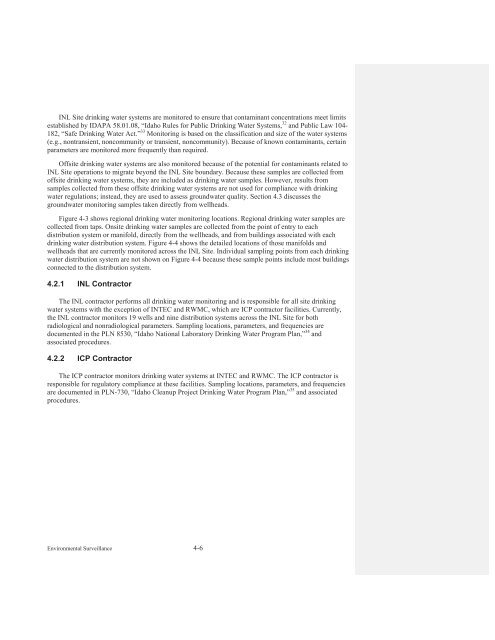Idaho National Laboratory Environmental Monitoring Plan
Idaho National Laboratory Environmental Monitoring Plan
Idaho National Laboratory Environmental Monitoring Plan
You also want an ePaper? Increase the reach of your titles
YUMPU automatically turns print PDFs into web optimized ePapers that Google loves.
INL Site drinking water systems are monitored to ensure that contaminant concentrations meet limits<br />
established by IDAPA 58.01.08, “<strong>Idaho</strong> Rules for Public Drinking Water Systems, 32 and Public Law 104-<br />
182, “Safe Drinking Water Act.” 33 <strong>Monitoring</strong> is based on the classification and size of the water systems<br />
(e.g., nontransient, noncommunity or transient, noncommunity). Because of known contaminants, certain<br />
parameters are monitored more frequently than required.<br />
Offsite drinking water systems are also monitored because of the potential for contaminants related to<br />
INL Site operations to migrate beyond the INL Site boundary. Because these samples are collected from<br />
offsite drinking water systems, they are included as drinking water samples. However, results from<br />
samples collected from these offsite drinking water systems are not used for compliance with drinking<br />
water regulations; instead, they are used to assess groundwater quality. Section 4.3 discusses the<br />
groundwater monitoring samples taken directly from wellheads.<br />
Figure 4-3 shows regional drinking water monitoring locations. Regional drinking water samples are<br />
collected from taps. Onsite drinking water samples are collected from the point of entry to each<br />
distribution system or manifold, directly from the wellheads, and from buildings associated with each<br />
drinking water distribution system. Figure 4-4 shows the detailed locations of those manifolds and<br />
wellheads that are currently monitored across the INL Site. Individual sampling points from each drinking<br />
water distribution system are not shown on Figure 4-4 because these sample points include most buildings<br />
connected to the distribution system.<br />
4.2.1 INL Contractor<br />
The INL contractor performs all drinking water monitoring and is responsible for all site drinking<br />
water systems with the exception of INTEC and RWMC, which are ICP contractor facilities. Currently,<br />
the INL contractor monitors 19 wells and nine distribution systems across the INL Site for both<br />
radiological and nonradiological parameters. Sampling locations, parameters, and frequencies are<br />
documented in the PLN 8530, “<strong>Idaho</strong> <strong>National</strong> <strong>Laboratory</strong> Drinking Water Program <strong>Plan</strong>,” 34 and<br />
associated procedures.<br />
4.2.2 ICP Contractor<br />
The ICP contractor monitors drinking water systems at INTEC and RWMC. The ICP contractor is<br />
responsible for regulatory compliance at these facilities. Sampling locations, parameters, and frequencies<br />
are documented in PLN-730, “<strong>Idaho</strong> Cleanup Project Drinking Water Program <strong>Plan</strong>,” 35 and associated<br />
procedures.<br />
<strong>Environmental</strong> Surveillance 4-6
















